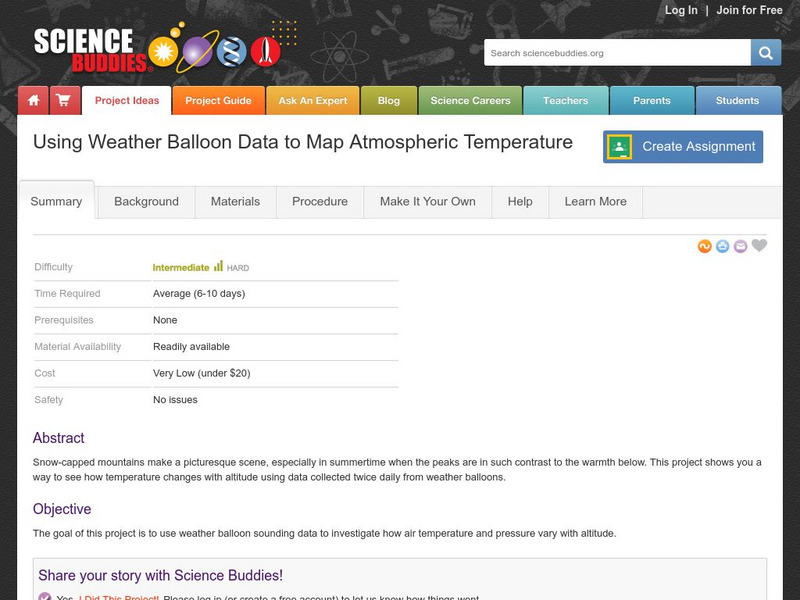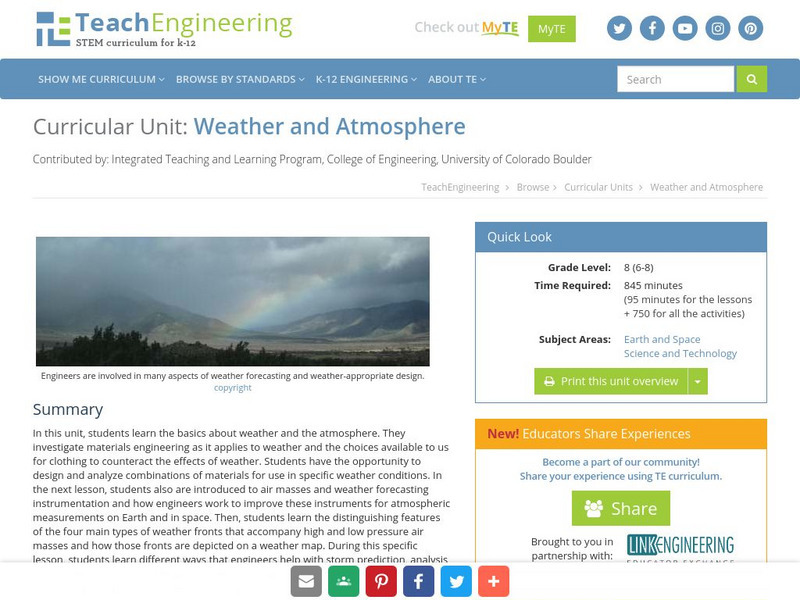Texas State University
Earth: Deposition and Lithification
Geology geniuses analyze sediment samples with a hand lens and sort according to physical characteristics. They also learn about the processes of cementation, compaction, and lithification within the rock cycle. The lesson plan is...
Discovery Education
Sonar & Echolocation
A well-designed, comprehensive, and attractive slide show supports direct instruction on how sonar and echolocation work. Contained within the slides are links to interactive websites and instructions for using apps on a mobile device to...
Curated OER
Reading Satellite Images
Students analyze satellite images. In this astronomy lesson, students examine 3 satellite images in order to understand how satellite images are taken and what they can teach scientists.
Curated OER
Geography: Water, Water Everywhere
Students discuss flooding and its causes. They view a Powerpoint presentation about floods and prevention methods. After creating a model with clay and pans, they investigate river behavior in various terrains with different amounts of...
Curated OER
Celsius Tells Temperature, Too
Second graders become aware that thermometer liquids expand or contract as temperature affects them.
Curated OER
The Sky and the Dichotomous Key
Students use a dichotomous key to distinguish between different types of clouds
Curated OER
Trees at Work... Just Look!
Students investigate the significance of trees. They collect magazine pictures of animals that live in trees, list products that are made from trees, collect twigs and create an item using the sticks, and bring in and discuss food from...
Curated OER
Bluebirds Project
In this bluebirds project worksheet, students are given directions on completing a project about bluebirds including measurements, scientific method questions, data entry, and more. Students complete 15 exercises.
Curated OER
Quartz DBQ
In this quartz worksheet, students read about the chemical composition of quartz and its commercial applications. Then students complete 7 short answer questions.
Curated OER
Water Quality Monitoring
Pupils comprehend the four parameters of water quality. They perform tests for salinity, dissolved oxygen, pH and clarity or turbidity. Students comprehend why scientists and environmental managers monitor water uality and aquatic...
Curated OER
Using Imported Data in Excel
Students import atmospheric data from the internet. For this earth science lesson, students graph the data they collected. They complete the worksheet after the activity.
Curated OER
Warm Me Up!
Third graders explore and identify heat sources. They conduct an experiment involving thermometers and articles of clothing, and record and discuss the results.
University Corporation for Atmospheric Research
Ucar: Satellites and Weather Teaching Box
Help your middle school student learn how satellites help make weather forecasts more accurate and how the COSMIC satellites collect data about the atmosphere by measuring bending radio waves.
Science Buddies
Science Buddies: Using Weather Balloon Data to Map Atmospheric Temperature
Snow-capped mountains make a picturesque scene, especially in summertime when the peaks are in such contrast to the warmth below. This project shows you a way to see how temperature changes with altitude using data collected twice daily...
Utah Education Network
Uen: Weather Watchers
Students will use weather instruments and the Internet to monitor the weather for a week. They will make graphs that compare weather factors analyze their relationships.
Science Buddies
Science Buddies: Make Your Own Psychrometer
From the name, you might guess that a psychrometer is an instrument designed to measure your thoughts. Actually, it is an instrument that can help you forecast the weather. Read more to find out how it works.
American Geosciences Institute
American Geosciences Institute: Earth Science Week: Look Up! Observing Weather
To get a better idea of how meteorologists make weather predictions, students will begin their own weather journals and make rain gauges.
Science Struck
Science Struck: How to Make a Wind Vane in 5 Easy Steps
Explains how to make and install a weather vane using simple materials. Includes illustrations.
Other
California Energy Commission: Science Projects: Make an Anemometer
Nice brief description of this wind speed device and the directions to make your own.
TeachEngineering
Teach Engineering: Weather and Atmosphere
In this unit, students learn the basics about weather and the atmosphere. They investigate materials engineering as it applies to weather and the choices available to us for clothing to counteract the effects of weather. Students have...
American Museum of Natural History
American Museum of Natural History: O Logy: Stuff to Do: Make a Weather Station
Make a wind vane, rain gauge, and barometer and learn how to measure wind direction, rainfall, and air pressure.
Science Buddies
Science Buddies: Make a Hygrometer With Strands of Hair
Does your hair go crazy when the weather turns damp? Did you know that strands of hair can relax and lengthen when the humidity increases and then contract again when the humidity decreases? In fact, hair strands can be used as the basis...
Other
Amazing Kids! Magazine: Predicting the Weather
Learn about how weather predictions can be made by different instruments in this article.
The Franklin Institute
Franklin Institute: Make Your Own Weather Station
This page, provided by the Franklin Institute, shows you how to become an amateur meteorologist. Directions on how to construct a weather station include the barometer, hygrometer, rain gauge, weather vane, and compass.




















